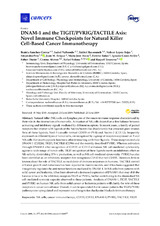Mostrar el registro sencillo del ítem
DNAM-1 and the TIGIT/PVRIG/TACTILE Axis: Novel Immune Checkpoints for Natural Killer Cell-Based Cancer Immunotherapy
| dc.contributor.author | Sánchez-Correa, Beatriz | |
| dc.contributor.author | Valhondo, Isabel | |
| dc.contributor.author | Hassouneh, Fakhri | |
| dc.contributor.author | López-Sejas, Nelson | |
| dc.contributor.author | Pera Rojas, Alejandra | |
| dc.contributor.author | Bergua, Juan M. | |
| dc.contributor.author | Arcos, María José | |
| dc.contributor.author | Bañas, Helena | |
| dc.contributor.author | Casas-Avilés, Ignacio | |
| dc.contributor.author | Durán, Esther | |
| dc.contributor.author | Alonso, Corona | |
| dc.contributor.author | Solana Lara, Rafael | |
| dc.contributor.author | Tarazona, Raquel | |
| dc.date.accessioned | 2019-06-24T07:18:09Z | |
| dc.date.available | 2019-06-24T07:18:09Z | |
| dc.date.issued | 2019 | |
| dc.identifier.uri | http://hdl.handle.net/10396/18766 | |
| dc.description.abstract | Natural killer (NK) cells are lymphocytes of the innate immune response characterized by their role in the destruction of tumor cells. Activation of NK cells depend on a fine balance between activating and inhibitory signals mediated by different receptors. In recent years, a family of paired receptors that interact with ligands of the Nectin/Nectin-like (Necl) family has attracted great interest. Two of these ligands, Necl-5 (usually termed CD155 or PVR) and Nectin-2 (CD112), frequently expressed on different types of tumor cells, are recognized by a group of receptors expressed on T and NK cells that exert opposite functions after interacting with their ligands. These receptors include DNAM-1 (CD226), TIGIT, TACTILE (CD96) and the recently described PVRIG. Whereas activation through DNAM-1 after recognition of CD155 or CD112 enhances NK cell-mediated cytotoxicity against a wide range of tumor cells, TIGIT recognition of these ligands exerts an inhibitory effect on NK cells by diminishing IFN-γ production, as well as NK cell-mediated cytotoxicity. PVRIG has also been identified as an inhibitory receptor that recognizes CD112 but not CD155. However, little is known about the role of TACTILE as modulator of immune responses in humans. TACTILE control of tumor growth and metastases has been reported in murine models, and it has been suggested that it negatively regulates the anti-tumor functions mediated by DNAM-1. In NK cells from patients with solid cancer and leukemia, it has been observed a decreased expression of DNAM-1 that may shift the balance in favor to the inhibitory receptors TIGIT or PVRIG, further contributing to the diminished NK cell-mediated cytotoxic capacity observed in these patients. Analysis of DNAM-1, TIGIT, TACTILE and PVRIG on human NK cells from solid cancer or leukemia patients will clarify the role of these receptors in cancer surveillance. Overall, it can be speculated that in cancer patients the TIGIT/PVRIG pathways are upregulated and represent novel targets for checkpoint blockade immunotherapy. | es_ES |
| dc.format.mimetype | application/pdf | es_ES |
| dc.language.iso | eng | es_ES |
| dc.publisher | MDPI | es_ES |
| dc.rights | https://creativecommons.org/licenses/by/4.0/ | es_ES |
| dc.source | Cancers 11(6), 877 (2019) | es_ES |
| dc.subject | NK cells | es_ES |
| dc.subject | Cancer immunotherapy | es_ES |
| dc.subject | CD155 | es_ES |
| dc.subject | CD112 | es_ES |
| dc.subject | DNAM-1 | es_ES |
| dc.subject | PVRIG | es_ES |
| dc.subject | TACTILE | es_ES |
| dc.subject | TIGIT | es_ES |
| dc.title | DNAM-1 and the TIGIT/PVRIG/TACTILE Axis: Novel Immune Checkpoints for Natural Killer Cell-Based Cancer Immunotherapy | es_ES |
| dc.type | info:eu-repo/semantics/article | es_ES |
| dc.relation.publisherversion | http://dx.doi.org/10.3390/cancers11060877 | es_ES |
| dc.relation.projectID | Gobierno de España. SAF2017-87538-R | es_ES |
| dc.relation.projectID | Instituto de Salud Carlos III. PI16/01615 | es_ES |
| dc.rights.accessRights | info:eu-repo/semantics/openAccess | es_ES |

